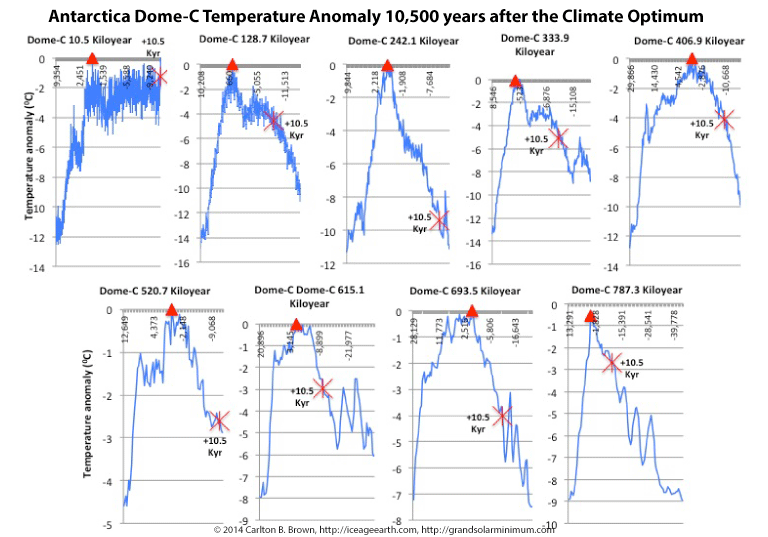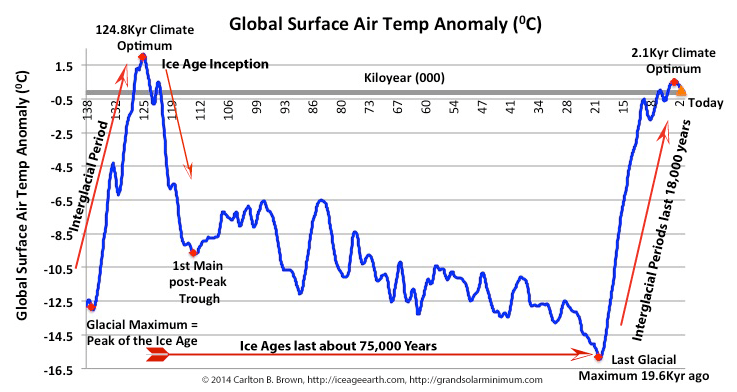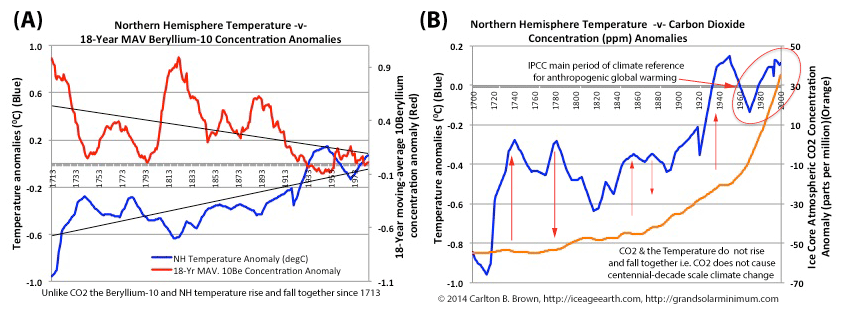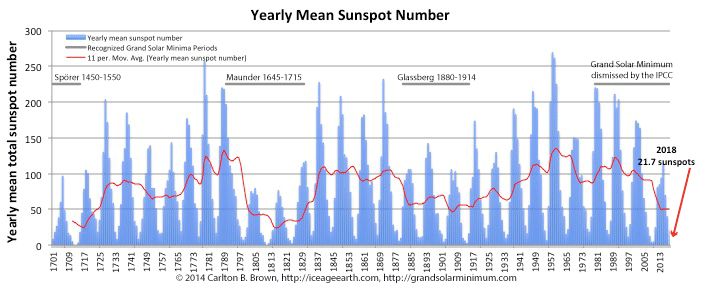Figure A) For the years 1406 to 1889, a statistically significant inverse relationship exists between the Northern Hemisphere temperature (blue line) and the solar activity proxy (i.e., 18-year moving average Beryllium 10 concentration anomaly)(red line)—that is, for 484 years of the Little Ice Age period. Both data parameter variations also tracked one another’s variations to a high degree, putatively indicating a cause-and-effect relationship. The correlation was maximized using an 18-year moving average of the Beryllium-10 concentration anomaly, over the raw Beryllium-10 data and a 5-year and 11-year moving average. The use of the 18-year moving average is the equivalent of saying the temperature lags behind the solar activity by about one 11-year solar cycle (see citation for why).[i] Beryllium-10 is produced in the atmosphere by high-energy cosmic ray collisions with oxygen and nitrogen atoms, and is a well-established proxy for solar activity. High Beryllium-10 ice core concentrations indicate low levels of solar activity, and vice versa.[ii]
Figure B) All four grand solar minima of the Little Ice Age were characterized by a strengthening of the relationship between the increasing 18-year moving average Beryllium-10 concentration anomaly and the declining Northern Hemisphere temperature anomaly. See the citation for the detailed analysis summary for Figures A and B.[iii]
Between 1400 and 1900, the Northern Hemisphere was on average about 10C colder than in the late 20th century, with this varying on a regional basis. The coldest region during the Little Ice Age was the Atlantic sector of the Arctic.[iv],[v] All four officially recognized grand solar minima of the Little Ice Age were associated with troughs in temperature in the Northern Hemisphere. These Little Ice Age grand solar minima were the Wolf (1280-1350), Spörer (1450-1550), Maunder (1645-1715), and Dalton (1790-1830) minima. These grand solar minima also coincided with the biggest glacier ice advances experienced since the Holocene Climate Optimum.[vi]
Based on the strong correlation between solar activity (Beryllium-10) and the Northern Hemisphere temperature during the Little Ice Age, if this relationship is repeated during this grand solar minimum, then the planet will cool. This conclusion is fully aligned with the consensus conclusion of solar scientists who are experts in climate change.[vii],[viii],[ix],[x],[xi],[xii],[xiii]
Click on this page and download a free copy of my book “Revolution: Ice Age Re-Entry,” and read more about this topic in Chapter 4.
[i] This 11-year solar cycle lag (approximate) is composed of 9 years (i.e., half of a 18-year moving average), plus a two year lag in the temperature rise (behind the Beryllium-10 rise), plus one year before the newly produced Beryllium-10 in the upper atmosphere reaches earth’s surface where it can be incorporated in ice cores (and thus be measured)(Beryllium-10 atmospheric residence time: R.C. Finkel and K. Nishiizumi, 1997, “Beryllium 10 concentrations in the Greenland Ice Sheet Project 2 ice core from 3–40 ka.” J. Geophys. Res., 102(C12), 26699–26706, doi: 10.1029/97JC01282).
[ii] I.G.M. Usoskin et al., “Solar activity, cosmic rays, and Earth’s temperature: A millennium-scale comparison.” Journal of Geophysical Research, 110, A10102, doi:10.1029/2004JA010946. [Exposé: See page 1. This tells us cosmogenic isotopes (Beryllium-10, Carbon-14) are used as proxies for solar activity, and that their production is caused by galactic cosmic ray flux, which is influenced by the solar system’s (heliospheric) magnetic field and is modulated by solar activity. Comment: Magnetized solar wind modulates the solar system’s magnetic shield (i.e., the heliosphere) and the earth’s magnetic shield (i.e. the magnetosphere), thereby regulating cosmic ray entry into the solar system and the earth system respectively. Cosmic ray entry into the upper atmosphere from space is modulated by solar activity and geomagnetism. Lower solar activity and lower geomagnetism permit more cosmic ray entry into the atmosphere, and conversely. Increased cosmic ray levels are associated with increased low-cloud formation, which is associated with planetary cooling, and conversely. The cosmic ray and low-cloud cooling effect are concentrated into the polar regions. Cosmogenic isotopes (Carbon-14, Beryllium-10) are generated by cosmic rays in the atmosphere, with more cosmic rays generating more cosmogenic isotopes, and conversely. Cosmogenic isotopes are then embedded in earth repositories (i.e., tree rings, ice cores) and therefore indirectly tell us about solar activity and the resulting magnetized solar wind that contacts the earth’s magnetosphere. By utilizing cosmogenic isotopes to assess relationships between the sun and earth systems (i.e., climate, volcanism) we know that the solar activity that is being assessed is magnetism based, and not electromagnetism (i.e. not solar irradiance).].
[iii] Data: (1) A.M. Berggren et al., 2009, “A 600-year annual 10Be record from the NGRIP ice core, Greenland.” Geophysical Research Letters, 36, L11801, doi:10.1029/2009GL038004. National Centers for Environmental Information, NESDIS, NOAA, U.S. Department of Commerce. North GRIP – 600 Year Annual 10Be Data. https://www.ncdc.noaa.gov/paleo-search/study/8618. Downloaded 05/05/2018. (2) T. Kobashi et al., 2013, “Causes of Greenland temperature variability over the past 4000 year: implications for Northern Hemispheric temperature changes.” Climate of the Past, 9(5), 2299-2317. doi: 10.5194/cp-9-2299-2013. National Centers for Environmental Information, NESDIS, NOAA, U.S. Department of Commerce. Northern Hemisphere 4000 Year Temperature Reconstructions. https://www.ncdc.noaa.gov/paleo/study/15535. Downloaded 05/05/2018. Statistics Software Utilized: Spearman rank calculator utilized: Wessa P., (2017), Spearman Rank Correlation (v1.0.3) in Free Statistics Software (v1.2.1), Office for Research Development and Education, URL https://www.wessa.net/rwasp_spearman.wasp/. Personal Research: Figure 4.4.A.) Spearman rank correlation r= -0.76, two-tailed P-value = <0.00001, N=484 annual pairings. Both the Northern Hemisphere temperature and the Beryllium-10 concentration anomaly (18-year moving average) anomalies were not normally distributed, though they did not contain outliers. A scatter plot of the data indicated a linear relationship. A Spearman rank correlation was utilized given the non-normal distributions. The correlation was optimized using an 18-year moving average Beryllium-10 concentration anomaly. This 18-year moving average was selected using the scatterplot trend line in Microsoft Excel to maximize the R-squared (versus an 11-year, 5-year, and no moving average). Figure B) A Spearman rank correlation r= -0.876, two-tailed P-value = <0.00001, N=205 annual pairings. A Pearson correlation r= -0.91, two-tailed P-value = <0.00001, N=205. The grand solar minima temperature decline phases and their corresponding 18-year trailing average Beryllium-10 data were extracted from the full data set and compiled into a single time series (as linked sequential periods). Each grand solar minimum period was analyzed as a stand-alone grand solar minimum data set (Data not shown) and as fusion of four grand solar minima. The results and conclusion are the same. The temperature data is normally distributed. The 18-year moving average Beryllium-10 concentration anomaly is not normally distributed, indicated by a d’Agostino-Pearson test that yielded a p=0.019, indicating a non-normal distribution. However, the scatter plot demonstrates a linear relationship, and there were no outliers. The correlation was optimized using a 18-year moving average Beryllium-10 concentration anomaly, selected using the scatterplot trend line in Microsoft Excel to maximize the R-squared (versus an 11-year, 5-year, and no moving average). Note: A Pearson correlation was also calculated for both data sets supporting Figures 4.4.A and B, yielding a similar level of correlation, statistical significance, and the same conclusion (Data not shown).
[iv] Michael E Mann, “Little Ice Age.” Volume 1, The Earth system: physical and chemical dimensions of global environmental change, 504–509, citing see Bradley and Jones, 1993; Pfister, 1995
[v] G.H. Miller et al., “Temperature and precipitation history of the Arctic.” Quaternary Science Reviews, Volume 29, Issues 15–16, 2010. 1679-1715. https://doi.org/10.1016/j.quascirev.2010.03.001.
[vi] O.N. Solomina et al., 2016, “Glacier fluctuations during the past 2000 years.” Quaternary Science Reviews, 149, 61-90. DOI: 10.1016/j.quascirev.2016.04.008. [See Figure 5, page 276. This figure collates a stacked time series of the number of glacier advances and recessions in each region into a global total.].
[vii] N. Scafetta, “Multi-scale harmonic model for solar and climate cyclical variation throughout the Holocene based on Jupiter-Saturn tidal frequencies plus the 11-year solar dynamo cycle.” Journal of Atmospheric and Solar-Terrestrial Physics (2012). doi:10.1016/j.jastp.2012.02.016.
[viii] Theodor Landscheidt, “New Little Ice Age Instead of Global Warming?” Energy & Environment. 2003. Volume 14, Issue 2, 327 – 350. https://doi.org/10.1260/095830503765184646.
[ix] R.J. Salvador, “A mathematical model of the sunspot cycle for the past 1000 years.” Pattern Recognition Physics, 1, 117-122, doi:10.5194/prp-1-117-2013, 2013.
[x] Habibullo Abdussamatov, “Current Long-Term Negative Average Annual Energy Balance of the Earth Leads to the New Little Ice age.” Thermal Science. 2015 Supplement, Volume 19, S279-S288.
[xi] Jan-Erik Solheim, https://www.mwenb.nl/wp-content/uploads/2014/10/Blog-Jan-Erik-Solheim-def.pdf. Referred from http://www.climatedialogue.org/what-will-happen-during-a-new-maunder-minimum/. Citing blog for 4-5 solar-climate experts.
[xii] Boncho P. Bonev et al., “Long-Term Solar Variability and the Solar Cycle in the 21st Century.” The Astrophysical Journal, 605:L81–L84, 2004 April 10.
[xiii] Nils-Axel Mörner, “Solar Minima, Earth’s rotation and Little Ice Ages in the past and in the future. The North Atlantic–European case.” Global and Planetary Change 72 (2010) 282–293. doi:10.1016/j.gloplacha.2010.01.004.







Recent Comments